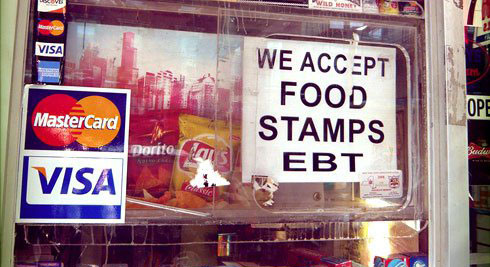
The following Letter To The Editor from the Progress Illinois website was submitted by the Economic Justice Team (Dan Lesser, Lena Silver, Kali Grant) at the Sargent Shriver National Center on Poverty Law.
Last week the Illinois Watchdog published an article that trivialized the effects of the Nov. 1 SNAP benefit cuts, stating they were “neither a surprise nor a problem.” The article propagates myths about the program and misses the larger point about the hunger crisis in this country: the USDA estimates that 49 million Americans are food insecure, meaning they lacked access to enough food for an active, healthy life for all household members, a number that will increase as a result of these cuts.
Myth: SNAP benefits are more than enough to feed a family.
Reality: Most SNAP recipients struggle to make their food last through the month; many rely on food pantries to close the gap.
The article gives the false impression that SNAP benefits are more than enough for families and individuals, even after the Nov. 1 cuts. It makes it sound like with a little elbow grease and persistence, families can comfortably make up for the reduction in benefits. One source, a nutritionist, suggests that if families just “cook [their] own food and do a little bargain shopping,” “that should be plenty.” She even goes so far as to suggest that an average individual needs no more than a $100 monthly food budget to stay healthy.
These assumptions don’t line up with reality.
Under the 2012 Thrifty Food Plan, which serves as the national standard for a nutritious diet at a minimal cost and is used as the basis for maximum food stamp allotments, the only monthly budget that falls under $100 is for a one-year-old. The plan estimates that an average 9-11 year old requires $151.40 a month for an adequate diet, and an average 19-50 year old requires $180.90.
Unfortunately, research shows that the the Thrifty Food Plan seriously underestimates the cost of a nutritious diet in today’s economy. In a study commissioned by the USDA, the Institute of Medicine and the National Research Council found that the Thrifty Food Plan is based on impractical and outdated calculations. Specifically, their research found the the Thrifty Food Plan:
- Includes impractical lists of foods,
- Lacks the variety called for in the Dietary Guidelines for Americans,
- Unrealistically assumes adequate facilities and time for food preparation,
- Unrealistically assumes food availability, particularly for low-income households living infood deserts,
- Unrealistically assumes food affordability,
- Unrealistically assumes adequate, affordable transportation,
- Underestimates food waste,
- Is exacerbated in its inadequacy by SNAP benefit calculations,
- Costs more than the SNAP allotment in many parts of the country, and
- Ignores special dietary needs.
By incorrectly interpreting the time and money tradeoffs and the unique limitations imposed on low-income individuals and families, the TFP fails to provide an adequate nutrition plan. Because of this, most participants struggle to make their benefits stretch through a full month. Ninety percent of monthly SNAP benefits are redeemed within two weeks. 58 percent of food bank clients are SNAP recipients who rely on food bank assistance at least 6 months out of the year. With the new cuts, the average cost per meal will drop to $1.40.
Politicians and others who took the “SNAP challenge” and experienced what life is like for millions of low-income Americans by living on the average daily SNAP allowance for one week have reaffirmed this conclusion, chronicling their own struggles to stay within the budget. Many reported feeling “tired,” and found that it was “hard to focus.” If politicians felt this terrible after a week, imagine the long-term effects on a growing child.
Myth: The House is proposing to limit SNAP benefits to people who are willing to work.
Reality: The proposed cuts would harshly punish those who want to work but cannot find a job.
In the article, U.S. Rep. Rodney Davis, a Republican from the 13th District who sits on the congressional committee responsible for SNAP spending, grossly mischaracterizes the House proposal to cut able-bodied adults with no dependent children from the program. He states that they simply have to work, “or do volunteer service or community service to get those benefits.”
Let’s set the facts straight.
Since 1996, welfare law has limited adults who aren’t disabled or caring for minor children to three months of SNAP benefits out of every three years, unless they are working at least 20 hours per week or participating in a qualifying workfare or job training program. Volunteer jobs and community service do not satisfy this requirement.
Current law allows states to request waivers from this 3 month cut-off for areas that have high unemployment or otherwise lack sufficient jobs-and more than 40 states, including Illinois, have requested and received such waivers in today’s weak economy.
The House proposal would eliminate all such waivers. It does not require states to offer job training or work-program placements to any of these individuals and provides no new funding for training programs-doing “volunteer service, or community service” will not qualify an indigent adult for SNAP under this law.
The bottom line? The House proposal means that people who pound the pavement looking for work but can’t find a job in an area with unemployment at 8, 10, even 25 percent would be summarily thrown off SNAP after three months. The average income of those who would be cut off by this draconian measure is 22 percent of the poverty line, about $2,500 a year for an individual.
Myth: SNAP enrollment is out of control.
Reality: SNAP enrollment rose appropriately with the recession’s high unemployment rate and will fall as the recovery progresses.
The article also cites the increase in SNAP enrollment over the past few years as reason for cutting back the program, ignoring that SNAP participation rose during the recession in response to increased need. As the number of unemployed people increased by 94% from 2007 to 2011, SNAP responded with a 70 percent increase in participation over the same period. Unemployment has begun to slowly fall, and SNAP participation growth has leveled off. The Congressional Budget Office projects that SNAP will return to 1995 levels as a share of GDP by 2019. Over the long term, SNAP is not growing faster than the overall economy and thus is not contributing to the nation’s long-term fiscal problems.
The deep cuts to SNAP proposed by the House come at a time when lower income families have yet to benefit from the economic recovery. There were nearly 6.7 million more poor people in 2012 than in 2008, the first full year of the Great Recession, and the poverty rate over the past three years has been stagnant at 15 percent.
As Senator Dick Durbin recently explained, SNAP is intended to act as a safety net during hard economic times, and it is one that the U.S. can’t afford to lose: “When we talk about cutbacks in the SNAP program, we’re talking about these people: the veterans, the children, the elderly, and the disabled.”
Photo: AP












Comments